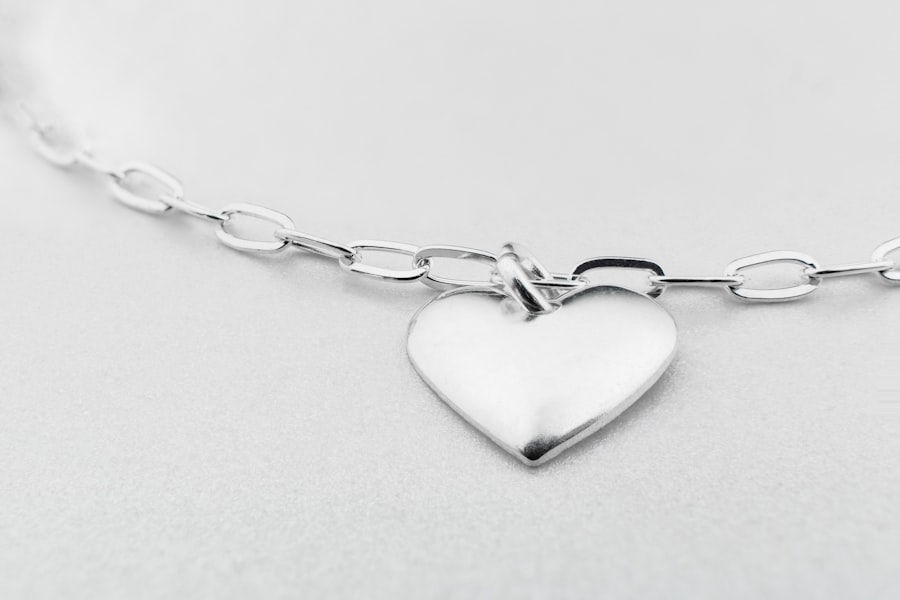The Tree of Life pendant is a powerful symbol that resonates across various cultures and belief systems. At its core, the Tree of Life represents interconnectedness, growth, and the cycle of life. It embodies the idea that all living things are connected through a shared existence, much like the branches of a tree that extend outward yet remain rooted in a common foundation.
This symbolism is particularly poignant in the context of family, as the branches can represent different generations, illustrating how lineage and heritage are intertwined. The roots signify stability and grounding, while the leaves and branches symbolize growth, potential, and the unfolding of life’s journey. In many spiritual traditions, the Tree of Life is also seen as a representation of wisdom and enlightenment.
It serves as a reminder of the importance of nurturing one’s inner self while remaining connected to the world around us. The pendant can act as a talisman, encouraging wearers to seek balance in their lives, to grow through experiences, and to embrace change as a natural part of existence. This multifaceted symbolism makes the Tree of Life pendant not just a piece of jewelry but a meaningful emblem that can inspire reflection and personal growth.
Key Takeaways
- The Tree of Life pendant symbolizes growth, strength, and connection to the earth and nature.
- Tree of Life pendants come in various styles such as Celtic, minimalist, and intricate designs, catering to different preferences.
- Common materials used in crafting Tree of Life pendants include sterling silver, gold, and gemstones, each adding a unique touch to the design.
- Tree of Life pendants can be worn on a chain as a necklace or on a cord as a choker, and can be styled with both casual and formal outfits.
- The Tree of Life symbol has roots in various cultures and religions, including ancient Mesopotamia, Norse mythology, and the Kabbalah, representing different aspects of life and spirituality.
Different Styles and Designs of Tree of Life Pendants
Intricate Designs with Added Symbolism
Some Tree of Life pendants feature intricate and detailed designs, showcasing elaborate depictions of the tree with finely crafted leaves and roots. These pendants often incorporate additional elements such as gemstones or crystals, which enhance their visual appeal and add layers of meaning. For example, a pendant adorned with amethyst might symbolize tranquility and spiritual growth, while one with emeralds could represent love and rebirth.
Minimalist Elegance
On the other hand, there are minimalist designs that focus on simplicity and elegance. These pendants may feature a basic outline of the tree or a stylized representation that emphasizes clean lines and geometric shapes. Such designs appeal to those who prefer understated elegance or wish to wear their symbolism subtly.
Abstract Interpretations
Some artisans create abstract interpretations of the Tree of Life, merging modern artistic styles with traditional symbolism. This fusion allows for a contemporary take on a timeless motif, making it accessible to a broader audience while still honoring its rich heritage.
Materials Used in Crafting Tree of Life Pendants

The materials used in crafting Tree of Life pendants vary widely, each contributing to the pendant’s overall aesthetic and meaning. Common materials include metals such as silver, gold, and bronze, which are often chosen for their durability and timeless appeal. Silver is particularly popular due to its bright luster and affordability, making it an accessible choice for many.
Gold, whether yellow or white, adds a touch of luxury and elegance, often associated with wealth and prosperity. Bronze offers a rustic charm that can evoke a sense of antiquity, appealing to those who appreciate vintage aesthetics. In addition to metals, many Tree of Life pendants incorporate natural elements such as wood or stone.
Wooden pendants can evoke a sense of earthiness and connection to nature, while stone pendants may feature semi-precious stones that not only enhance beauty but also carry specific meanings based on their properties. For example, turquoise is often associated with protection and healing, while rose quartz symbolizes love and compassion. The combination of these materials allows for a rich tapestry of textures and colors, making each pendant unique and meaningful.
How to Wear and Style a Tree of Life Pendant
| Step | Description |
|---|---|
| 1 | Choose a chain or cord that complements the pendant |
| 2 | Decide on the length of the chain or cord |
| 3 | Match the pendant with appropriate outfits |
| 4 | Avoid wearing the pendant with high-collared tops |
| 5 | Consider layering the pendant with other necklaces |
Wearing a Tree of Life pendant can be both a fashion statement and a personal expression of one’s beliefs or values. The versatility of these pendants allows them to be styled in various ways, making them suitable for different occasions. For casual outings, pairing a simple silver or wooden Tree of Life pendant with a basic t-shirt or sweater can create an effortlessly chic look.
Layering it with other necklaces can add depth to the ensemble; for instance, combining it with shorter chains or chokers can create an interesting visual contrast. For more formal occasions, a more ornate Tree of Life pendant can serve as a stunning focal point. Wearing it over a classic dress or blouse can elevate the outfit while adding an element of personal significance.
Choosing pendants with gemstones can also enhance the overall look; for example, wearing an emerald-studded Tree of Life pendant with an elegant evening gown can create a sophisticated appearance that draws attention without being overly ostentatious. The key is to ensure that the pendant complements the outfit rather than overpowering it.
The History and Origins of the Tree of Life Symbol
The Tree of Life symbol has ancient roots that span across various cultures and civilizations. Its origins can be traced back to early religious texts and mythologies where it often represented creation, fertility, and immortality. In ancient Mesopotamian cultures, for instance, the Tree of Life was depicted in art and literature as a sacred entity that provided sustenance and wisdom to humanity.
Similarly, in Norse mythology, Yggdrasil is an immense ash tree that connects the nine worlds, symbolizing the interconnectedness of all life. In addition to these ancient references, the Tree of Life has also found its place in religious texts such as the Bible. In Christianity, it appears in the Garden of Eden as a symbol of divine knowledge and eternal life.
The Kabbalistic tradition within Judaism also features the Tree of Life as a mystical diagram representing the structure of creation and the path to spiritual enlightenment. This rich historical tapestry illustrates how the Tree of Life has transcended time and culture, evolving into a universal symbol that continues to resonate with people today.
The Spiritual and Cultural Significance of the Tree of Life

The spiritual significance of the Tree of Life extends beyond its aesthetic appeal; it serves as a profound reminder of our connection to nature and each other. In many spiritual practices, it symbolizes personal growth and transformation. The roots represent our past experiences and heritage, while the trunk signifies our present journey through life.
The branches reaching toward the sky embody our aspirations and dreams for the future. This holistic view encourages individuals to reflect on their life paths and recognize how their experiences shape who they are. Culturally, the Tree of Life holds different meanings across various societies.
In Celtic traditions, it symbolizes strength and resilience due to its deep roots and expansive branches. Native American cultures often view it as a sacred symbol representing harmony with nature and respect for all living beings. In Asian cultures, particularly in Buddhism, it signifies enlightenment and spiritual awakening.
This diverse cultural significance highlights how the Tree of Life transcends geographical boundaries, uniting people through shared values related to growth, connection, and spirituality.
The Best Occasions to Wear a Tree of Life Pendant
The versatility of the Tree of Life pendant makes it suitable for numerous occasions throughout life’s journey. One significant occasion is family gatherings or reunions where wearing this pendant can serve as a reminder of familial bonds and heritage. It can spark conversations about ancestry and shared experiences among relatives, reinforcing connections that may have faded over time.
Additionally, during milestones such as weddings or anniversaries, wearing a Tree of Life pendant can symbolize growth within relationships and the nurturing aspect that love requires. Moreover, many individuals choose to wear their Tree of Life pendants during personal milestones such as graduations or new job opportunities. These moments often signify new beginnings and personal growth; thus, having a symbol that embodies these themes can provide encouragement and motivation.
Furthermore, during times of reflection or meditation, wearing this pendant can enhance one’s spiritual practice by serving as a focal point for contemplation on life’s interconnectedness.
Where to Find and Purchase High-Quality Tree of Life Pendants
Finding high-quality Tree of Life pendants requires careful consideration regarding craftsmanship and materials used in their creation.
These venues provide an opportunity to connect with creators directly, allowing buyers to learn about the inspiration behind each piece while ensuring they are purchasing something truly special.
Online platforms also offer an extensive range of options for those seeking Tree of Life pendants. Websites specializing in handmade jewelry often feature collections from various artisans worldwide, providing access to diverse styles that may not be available locally.
Additionally, reputable jewelers often provide detailed descriptions regarding materials used in their products along with care instructions—information that can help buyers make informed decisions about their purchases. In conclusion, whether worn as an accessory or cherished as a meaningful symbol, the Tree of Life pendant encapsulates profound themes that resonate deeply within human experience. Its rich history, diverse styles, and cultural significance make it not just an ornament but an emblematic representation of life’s interconnectedness.
FAQs
What is a tree of life pendant?
A tree of life pendant is a piece of jewelry that features a design resembling a tree with branches and roots. It is often symbolic of growth, strength, and connection to nature.
What materials are tree of life pendants made from?
Tree of life pendants can be made from various materials, including sterling silver, gold, stainless steel, and gemstones. They may also incorporate other materials such as wood or leather.
What is the significance of a tree of life pendant?
The tree of life symbolizes many different things across different cultures and belief systems, including wisdom, protection, and interconnectedness. It is often seen as a representation of the cycle of life and the interconnectedness of all living things.
How are tree of life pendants worn?
Tree of life pendants are typically worn as necklaces, either on a chain or a cord. They can be worn as a standalone statement piece or layered with other necklaces for a more personalized look.
Are tree of life pendants suitable for all ages?
Yes, tree of life pendants are versatile and can be worn by individuals of all ages. They make meaningful gifts for women of all ages, from young girls to older women.

